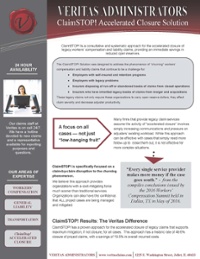
PEOs: Are Your Legacy WC Claims Receiving the Attention They Deserve?

Dealing with legacy workers’ compensation claims has been a growing challenge for many PEO organizations who carry open reserve dollars on older or “churning” claims. As Robert Rice writes within NAPEO’s PEO Insider magazine “PEOs are generally highly focused on the details of Workers' Compensation insurance given that it is one of the single largest day-to-day risks they manage.“
When it comes to legacy claims, they often receive limited attention and no urgency from the TPA handling these claims. The standard TPA model is based on assembly line claims management for a high volume of new claims. This reality costs employers large amounts of money.
Making things more difficult for PEOs can be changing TPA firms, customer mergers, and acquisitions, layoffs or closing operations. This can increase the likelihood of lesser-managed claims and require even more urgency for the closure of related legacy claims.
The good news is that accelerated closure expertise can help by outsourcing the oversight of these claims to a specialized 3rd party firm for critical review, disruption, tactical plans, and resolution.
Accelerated Closure with a Focus on all Cases, not Just “Low Hanging Fruit”
Many firms that provide these legacy claims services assume the activity of “accelerated closure” involves merely increasing communications and pressure on adjusters’ existing workload. While this approach can be effective with cases that simply need more follow-up to close them out, it is not sufficient for more complex situations.
This approach is based more on how these firms are compensated. The concept is positioned as a “no money upfront” deal that pays out a percentage of closure savings. This “gain-share” approach only benefits the firm itself, and they will have no interest to provide a consistent effort at mitigating every case.

Quality Over Quantity
Organizations that use a consultative and systematic approach for the accelerated closure of legacy claims can result in providing immediate savings in reduced open reserves.
To accomplish this, there needs to be a plan for oversight and aggressive mitigation, if not closure, of every claim – not just the easy ones. This requires spending a significant amount of initial time understanding alternate strategies and changing plans that were not working in the first place.
The first step is to reset the claim strategy in the context of forcing closure opportunity for all claims. This approach will result in immediate hard dollar savings by reducing open reserves. Historically, this approach has provided a 49.6% closure rate of project claims yielding an average savings of 19.5% in overall incurred costs.
Another benefit of this approach is that you will never have to worry that specific claims will be worse off at project’s end because the project team aborted all intervention when no reserve savings were possible. We also understand the fact that cases change all the time and managing a case that “goes bad” during the life of a project is critical to mitigation of the ultimate result.
Conclusion
TPAs who practice assembly line claims processes that rely on high claim volumes are more interested identifying the “low hanging fruit.” The more difficult cases are avoided only making them worse.
By implementing a consultative and systematic approach for the accelerated closure of legacy claims, PEOs can realize immediate hard dollar savings in reduced open reserves. PEO’s can also have the confidence that ALL project cases are being managed and mitigated – not just the easy ones.
Click below to learn more about our ClaimStop! Accelerated Closure solution.


